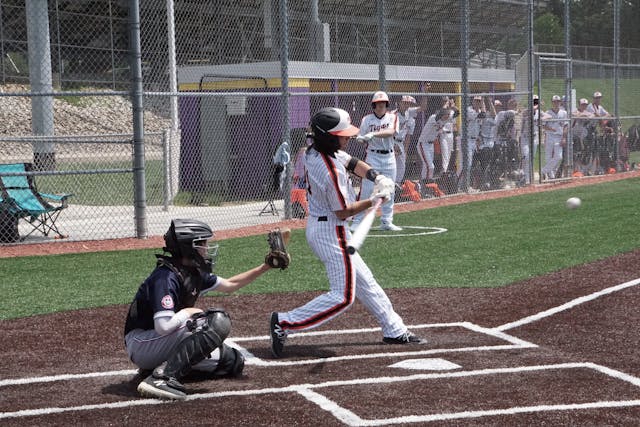
How can a baseball player possibly hit the ball? They have to swing at where they think the ball will be because they cannot actually see it.
There are different types of baseball pitches, and they travel at different speeds, so let’s just look at the fastball, which is a simple and straight pitch. The fastest baseball pitch in MLB history was 170.3 km/h (105.8 mph). This was thrown by Aroldis Chapman in September 2010. Chapman also has the next 6 fastest baseball pitching times as well. However, that is something of an anomaly. Let’s look at average speeds. The average fastball pitch speed is 148 km/h (92 mph).
The pitcher’s mound is 18.4 m (60.5 feet) from the home plate where the batter stands. That means a 148 km/h fastball travels that 18.4 m in 0.44 seconds. Aroldis Chapman’s fastball takes 0.38 seconds to travel the distance to the batter. I know that is not exact because the baseball starts to slow down the second it leaves the pitcher’s hand. The ball’s speed is provided by the muscles of the pitcher and the mechanics of the pitch. Once the ball is out of the pitcher’s hand, it has no extra energy and can only lose speed because of air resistance. However, let’s work with that 0.44 seconds.
440 milliseconds is an incredibly short time. It takes between 100 and 400 milliseconds to blink! If the batter happens to blink when the pitches pitches, they could miss the entire flight of the ball. So, the first question is, can the batter actually see the ball? To be able to see the ball and have the bat where the ball is going to be, the batter’s brain needs to do three things: receive the visual signals from the eyes, process the information and work out where the ball is going, and instruct the arms to be in the right position. Think about what happens when you are going to catch a ball that is thrown at you. Your eyes see the ball and send the signal to your brain. Your brain processes the information and works out the trajectory of the ball. And then your brain sends the instructions to your arm and hand muscles so that they are in the correct place to intercept the ball. How long does that take?
Once the ball leaves the pitcher’s hand, the light has already reached the batter’s eyes because the speed of light is not something we need to take into account. The light hits the cones, creates an electrical signal, and whizzes up the optic nerve to the brain. It takes about 100 milliseconds for the image to reach the brain. It might actually be faster than that. Studies by MIT have shown that the brain can process an entire image in as little as 13 milliseconds and baseball players have the advantage that they already know what they are looking for. Once the signal reaches the brain it has to analyze the trajectory of the ball, and that takes about 150 milliseconds. Then it takes about 25 milliseconds for the brain to decide whether to swing or not. Once that decision is made, the signals get sent to the muscles and it takes about 150 milliseconds for the muscles to start moving. That is a total of about 425 milliseconds, leaving 15 milliseconds. That means it is almost impossible for a baseball player to see the ball, react, and hit it. And yet they do. Consistently. How?
A lot of it comes down to practice and prediction. If you or I faced a fastball (assuming you are not an MLB player), we wouldn’t be able to swing until long after the ball had passed. We would wait to really see the ball before we reacted, which would be way too late. Professional players use two things to help them. Firstly, they have practiced so many times and faced so many pitchers that their reaction time has been honed. Their brain is expecting the ball and the connections in their brains are prepped for the reaction. That is basically muscle memory. Their brains don’t have to analyze the information as much as ours would.
The second thing is they are able to predict what is going to happen far more clearly than we could. They have faced so many pitches that their brains are able to see the pitcher’s stance, the movement, probably even the weather, and be able to compare that to past pitches. Their brains “knows” where a pitch like that will generally go and that helps them react without having to analyze as much information as we can. The more often we are exposed to a stimulus, the faster our brain becomes at recognizing it. With training, we would become much better at hitting faster pitches, but to be at the top level probably requires some genetic mutation that gives very fast reaction times. And this is what I learned today.
Photo by Mark Milbert: https://www.pexels.com/photo/people-playing-baseball-8312441/
Sources
https://www.usatoday.com/story/sports/mlb/2024/05/29/fastest-pitches-in-mlb-history/73883662007
https://www.mlb.com/official-information/basics/field
https://bionumbers.hms.harvard.edu/bionumber.aspx?id=100706&ver=0
https://www.performancevisioninc.com/blog/41/how-is-a-fastball-seen-by-baseball-players
https://appliedvisionbaseball.com/can-baseball-players-see-the-ball-off-the-bat
https://www.syte.ai/blog/ecommerce-trends/this-is-how-quickly-the-brain-processes-images
